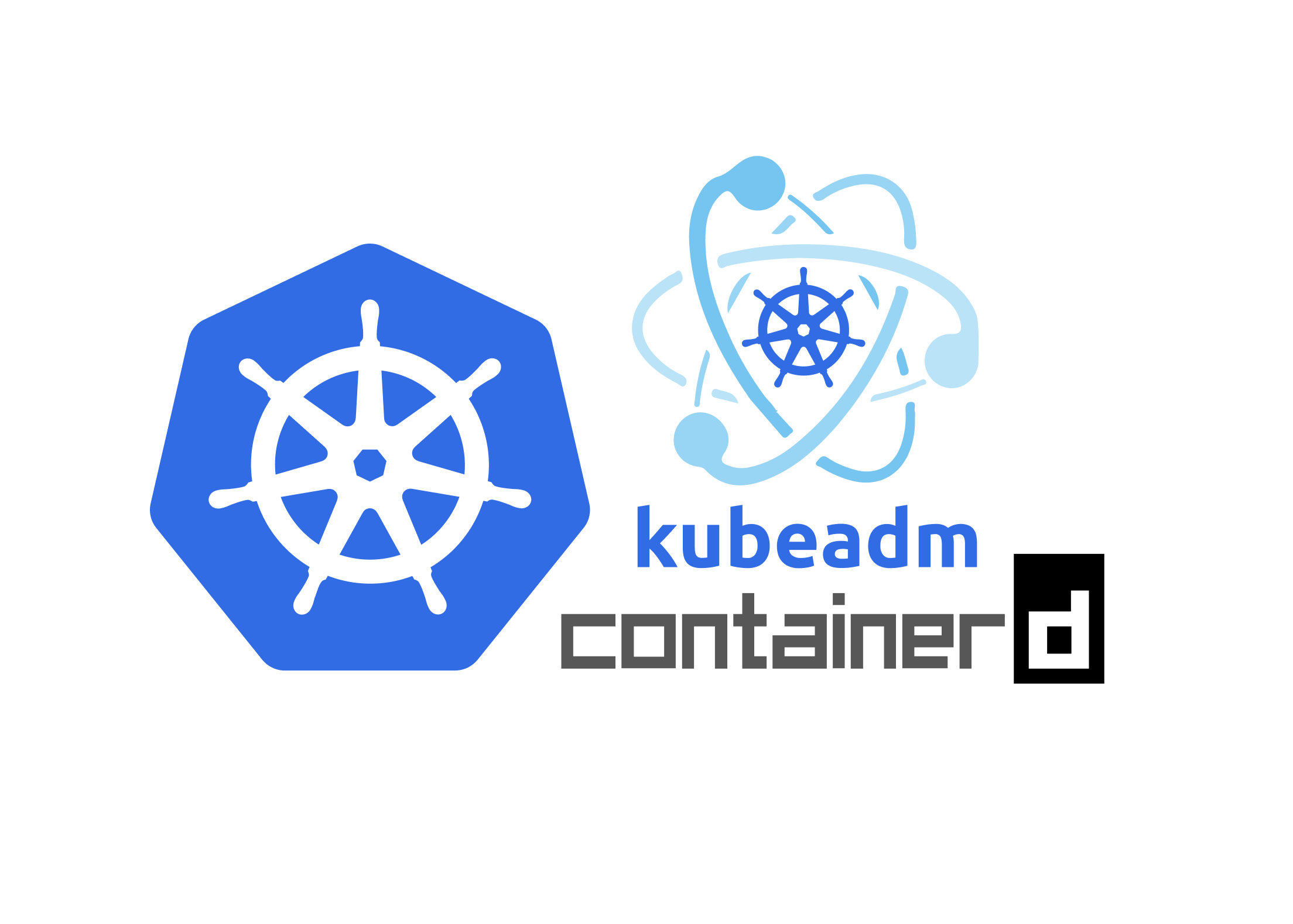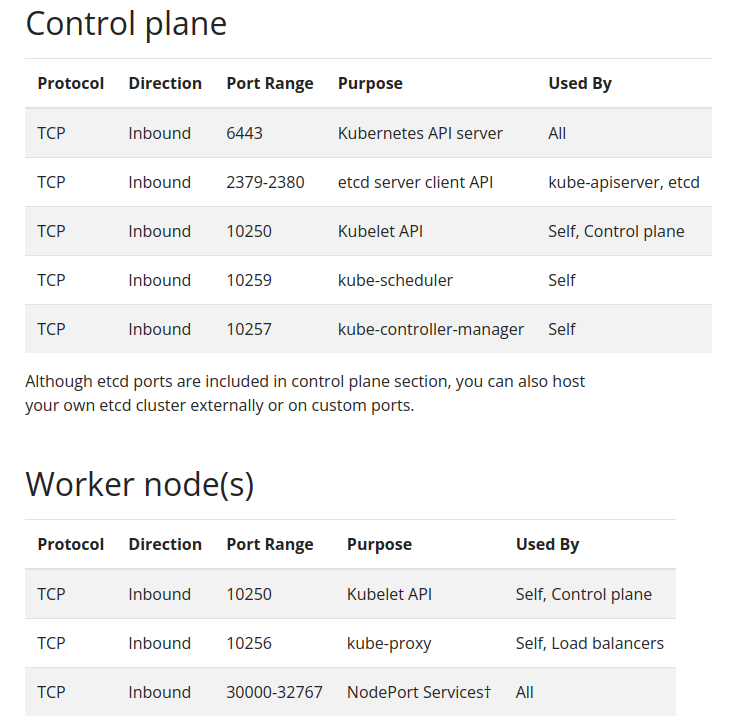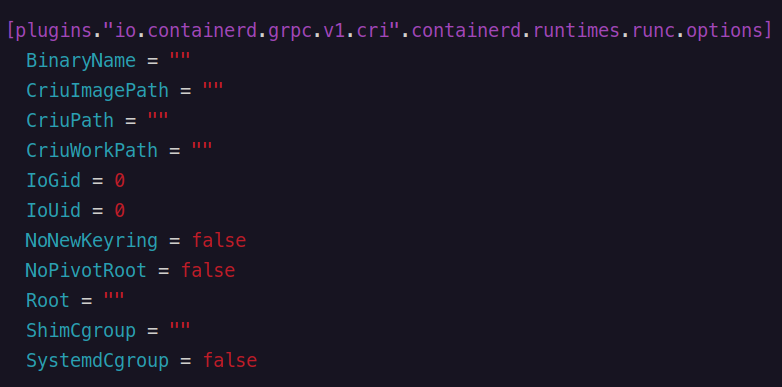Creating a Kubernetes Cluster with Kubeadm and Containerd: A Comprehensive Step-by-Step Guide
 Pratik Jagrut
Pratik Jagrut
Introduction
Kubeadm is a tool designed to simplify the process of creating Kubernetes clusters by providing kubeadm init and kubeadm join commands as best-practice "fast paths." - Kubernetes documentation
In this blog, we'll go through the step-by-step process of installing a Kubernetes cluster using Kubeadm.
Prerequisites
Before you begin, ensure you have the following:
Ensure you have a compatible Linux host (e.g., Debian-based and Red Hat-based distributions). In this blog, we're using Ubuntu which is a Debian-based OS.
At least 2 GB of RAM and 2 CPUs per machine.
Full network connectivity between all machines in the cluster.
Unique hostname, MAC address, and product_uuid for every node.
Ensure all the required ports are open for the control plane and the worker nodes. You can refer to Ports and Protocols or see the screenshot below.

Disable swap on all the nodes.
sudo swapoff -a
# disable swap on startup in /etc/fstab
sudo sed -i '/ swap / s/^/#/' /etc/fstab
Setup container runtime(Containerd)
To run containers in Pods, Kubernetes uses a container runtime. By default, Kubernetes employs the Container Runtime Interface (CRI) to interact with your selected container runtime. Each node needs to have container runtime installed. In this blog, we'll use containerd.
Run these instructions on all the nodes. I am using Ubuntu on all the nodes.
Enable IPv4 packet forwarding:
# sysctl params required by setup, params persist across reboots cat <<EOF | sudo tee /etc/sysctl.d/k8s.conf net.ipv4.ip_forward = 1 EOF # Apply sysctl params without reboot sudo sysctl --systemRun
sudo sysctl net.ipv4.ip_forwardto verify thatnet.ipv4.ip_forwardis set to 1Specify and load the following kernel module dependencies:
cat <<EOF | sudo tee /etc/modules-load.d/k8s.conf overlay br_netfilter EOF sudo modprobe overlay sudo modprobe br_netfilterInstall containerd:
Add Docker's official GPG key:
sudo apt-get update sudo apt-get -y install ca-certificates curl sudo install -m 0755 -d /etc/apt/keyrings sudo curl -fsSL https://download.docker.com/linux/ubuntu/gpg -o /etc/apt/keyrings/docker.asc sudo chmod a+r /etc/apt/keyrings/docker.ascAdd the repository to Apt sources:
echo \ "deb [arch=$(dpkg --print-architecture) signed-by=/etc/apt/keyrings/docker.asc] https://download.docker.com/linux/ubuntu \ $(. /etc/os-release && echo "$VERSION_CODENAME") stable" | \ sudo tee /etc/apt/sources.list.d/docker.list > /dev/nullInstall containerd
sudo apt-get update sudo apt-get -y install containerd.ioFor more details, refer to the Official installation documentation
Configure systemd cgroup driver for containerd
First, we need to create a containerd configuration file at the location
/etc/containerd/config.tomlsudo mkdir -p /etc/containerd sudo containerd config default | sudo tee /etc/containerd/config.tomlNow, we enable the systemd cgroup driver for the CRI in
/etc/containerd/config.tomlat section[plugins."io.containerd.grpc.v1.cri".containerd.runtimes.runc.options]setSystemCgroup = true
OR we can just run
sudo sed -i "s/SystemdCgroup = false/SystemdCgroup = true/g" "/etc/containerd/config.toml"Restart containerd
sudo systemctl restart containerdContainerd should be running, check the status using:
sudo systemctl status containerd
Install kubeadm, kubelet and kubectl
Run these commands on all nodes. These instructions are for Kubernetes v1.30.
Install
apt-transport-https, ca-certificates, curl, gpgpackagessudo apt-get update sudo apt-get install -y apt-transport-https ca-certificates curl gpgDownload the public signing key for the Kubernetes package repositories
curl -fsSL https://pkgs.k8s.io/core:/stable:/v1.30/deb/Release.key | sudo gpg --dearmor -o /etc/apt/keyrings/kubernetes-apt-keyring.gpgAdd the
aptrepository for Kubernetes 1.30echo 'deb [signed-by=/etc/apt/keyrings/kubernetes-apt-keyring.gpg] https://pkgs.k8s.io/core:/stable:/v1.30/deb/ /' | sudo tee /etc/apt/sources.list.d/kubernetes.listInstall kubelet, kubeadm and kubectl
sudo apt-get update sudo apt-get install -y kubelet kubeadm kubectl sudo apt-mark hold kubelet kubeadm kubectlThis is optional, Enable the kubelet service before running kubeadm
sudo systemctl enable --now kubelet
Initialize the k8s control plane
Run these instructions only on the control plane node
kubeadm init
To initialize the control plane, run the
kubeadm initcommand. You also need to choose a pod network add-on and deploy aContainer Network Interface (CNI)so that your Pods can communicate with each other. Cluster DNS (CoreDNS) will not start until a network is installed.We will use Calico CNI, so set the
--pod-network-cidr=192.168.0.0/16.sudo kubeadm init --pod-network-cidr=192.168.0.0/16Now, at the end of the
kubeadm initcommand, you'll seekubeadm joincommandsudo kubeadm join <control-plane-ip>:<control-plane-port> --token <token> --discovery-token-ca-cert-hash <hash>copy it and keep it safe.Run the following commands to set kubeconfig to access the cluster using kubectl
mkdir -p $HOME/.kube sudo cp -i /etc/kubernetes/admin.conf $HOME/.kube/config sudo chown $(id -u):$(id -g) $HOME/.kube/configNow, check the node using
$ kubectl get nodes NAME STATUS ROLES AGE VERSION ip-zzz-zz-z-zz NotReady control-plane 114s v1.30.2The node is in
NotReadystate becausemessage: 'container runtime network not ready: NetworkReady=false reason:NetworkPluginNotReady message:Network plugin returns error: cni plugin not initialized' reason: KubeletNotReady. After setting up the CNI, the node should be in a Ready state.Set Up a Pod Network
We must deploy a Container Network Interface (CNI) based Pod network add-on so that Pods can communicate with each other.
Install the calico operator on the cluster.
kubectl create -f https://raw.githubusercontent.com/projectcalico/calico/v3.28.0/manifests/tigera-operator.yamlDownload the custom resources necessary to configure Calico.
kubectl create -f https://raw.githubusercontent.com/projectcalico/calico/v3.28.0/manifests/custom-resources.yamlVerify all the Calico pods are in running state.
$ kubectl get pods -n calico-system NAME READY STATUS RESTARTS AGE calico-kube-controllers-6f459db86d-mg657 1/1 Running 0 3m36s calico-node-ctc9q 1/1 Running 0 3m36s calico-typha-774d5fbdb7-s7qsg 1/1 Running 0 3m36s csi-node-driver-bblm8 2/2 Running 0 3m3Verify that the node is in a running state
$ kubectl get nodes NAME STATUS ROLES AGE VERSION ip-xxx-xx-x-xx Ready control-plane 2m46s v1.30.2
Join the worker nodes
Ensure containerd, kubeadm, kubectl, and kubelet are installed on all worker nodes, then run sudo kubeadm join <control-plane-ip>:<control-plane-port> --token <token> --discovery-token-ca-cert-hash <hash>, which you can find at the end of the kubeadm init command's output.
Check the cluster state
Run these commands on the control-plane node since the worker nodes do not have the kubeconfig file.
Check if the worker nodes are joined to the cluster.
$ kubectl get nodes NAME STATUS ROLES AGE VERSION ip-xxx-xx-xx-xx Ready <none> 9m9s v1.30.2 ip-yyy-yy-yy-yy Ready <none> 23s v1.30.2 ip-zzz-zz-z-zz Ready control-plane 27m v1.30.2To add a worker role to the worker node we can use
kubectl label node <node-name> node-role.kubernetes.io/worker=workercommand.$ kubectl get nodes NAME STATUS ROLES AGE VERSION ip-xxx-xx-xx-xx Ready worker 12m v1.30.2 ip-yyy-yy-yy-yy Ready worker 3m51s v1.30.2 ip-zzz-zz-z-zz Ready control-plane 31m v1.30.2Check the workload running on the cluster
$ kubectl get pods -A NAMESPACE NAME READY STATUS RESTARTS AGE calico-apiserver calico-apiserver-6fcb65fbd5-n4wsn 1/1 Running 0 35m calico-apiserver calico-apiserver-6fcb65fbd5-nnggl 1/1 Running 0 35m calico-system calico-kube-controllers-6f459db86d-mg657 1/1 Running 0 35m calico-system calico-node-ctc9q 1/1 Running 0 35m calico-system calico-node-dmgt2 1/1 Running 0 18m calico-system calico-node-nw4t5 1/1 Running 0 9m49s calico-system calico-typha-774d5fbdb7-s7qsg 1/1 Running 0 35m calico-system calico-typha-774d5fbdb7-sxb5c 1/1 Running 0 9m39s calico-system csi-node-driver-bblm8 2/2 Running 0 35m calico-system csi-node-driver-jk4sz 2/2 Running 0 18m calico-system csi-node-driver-tbrrj 2/2 Running 0 9m49s kube-system coredns-7db6d8ff4d-5f7s5 1/1 Running 0 37m kube-system coredns-7db6d8ff4d-qj9r8 1/1 Running 0 37m kube-system etcd-ip-zzz-zz-z-zz 1/1 Running 0 37m kube-system kube-apiserver-ip-zzz-zz-z-zz 1/1 Running 0 37m kube-system kube-controller-manager-ip-zzz-zz-z-zz 1/1 Running 0 37m kube-system kube-proxy-dq8k4 1/1 Running 0 9m49s kube-system kube-proxy-t2sw9 1/1 Running 0 18m kube-system kube-proxy-xd6nn 1/1 Running 0 37m kube-system kube-scheduler-ip-zzz-zz-z-zz 1/1 Running 0 37m tigera-operator tigera-operator-76ff79f7fd-jj4kf 1/1 Running 0 35m
Conclusion
Setting up a Kubernetes cluster with Kubeadm involves a clear and structured process. You can create a functional cluster by meeting all prerequisites, configuring the container runtime, and installing Kubernetes components. Using Calico for networking ensures seamless pod communication. With the control plane and worker nodes properly configured and joined, you can efficiently manage and deploy workloads across your Kubernetes cluster.
Thank you for reading this blog; your interest is greatly appreciated, and I hope it helps you on your Kubernetes journey; in the next article, we'll explore running workloads in the Kubernetes cluster.
Subscribe to my newsletter
Read articles from Pratik Jagrut directly inside your inbox. Subscribe to the newsletter, and don't miss out.
Written by

Pratik Jagrut
Pratik Jagrut
👋 Hey there! I'm a community-driven software engineer, and I absolutely love diving into the world of cloud-native development and exploring the endless possibilities of open-source technologies. 💻 My skill set revolves around Kubernetes, GoLang, Python, Docker, and other fascinating container technologies. 🚀 And hey, just to add to the mix, I'm also CKA certified! 🎓 But you know what? My journey doesn't stop at coding. I have a genuine passion for technical evangelism. 🎤 I've had the privilege to speak at world-renowned events, sharing my knowledge and insights with others. It's such an exhilarating experience! And when I'm not on stage, you can find me pouring my thoughts into engaging technical blogs. 📝 If you've made it this far and you're intrigued by what you've read, let's not leave it at that! Reach out, and let's connect. Who knows what exciting opportunities may be awaiting us? 😊